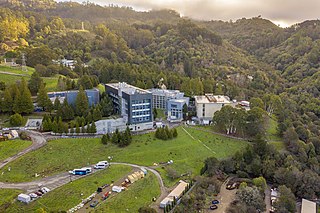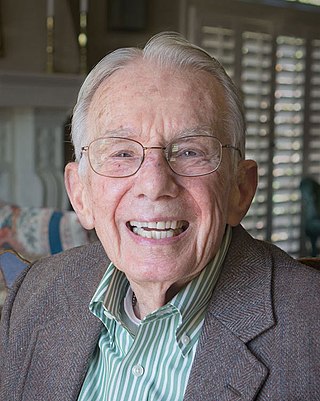Related Research Articles

Lawrence Berkeley National Laboratory (LBNL) is a federally funded research and development center in the hills of Berkeley, California, United States. Established in 1931 by the University of California (UC), the laboratory is sponsored by the United States Department of Energy and administered by the UC system. Ernest Lawrence, who won the Nobel prize for inventing the cyclotron, founded the Lab and served as its Director until his death in 1958. Located in the Berkeley Hills, the lab overlooks the campus of the University of California, Berkeley.

The Energy Policy Act of 2005 is a federal law signed by President George W. Bush on August 8, 2005, at Sandia National Laboratories in Albuquerque, New Mexico. The act, described by proponents as an attempt to combat growing energy problems, changed US energy policy by providing tax incentives and loan guarantees for energy production of various types. The most consequential aspect of the law was to greatly increase ethanol production to be blended with gasoline. The law also repealed the Public Utility Holding Company Act of 1935, effective February 2006.

Arthur Hinton Rosenfeld was a University of California, Berkeley physicist and California energy commissioner, dubbed the "Godfather of Energy Efficiency", for developing new standards which helped improve energy efficiency in California and subsequently worldwide.

The energy policy of the United States is determined by federal, state, and local entities. It addresses issues of energy production, distribution, consumption, and modes of use, such as building codes, mileage standards, and commuting policies. Energy policy may be addressed via legislation, regulation, court decisions, public participation, and other techniques.

A Zero-Energy Building (ZEB), also known as a Net Zero-Energy (NZE) building, is a building with net zero energy consumption, meaning the total amount of energy used by the building on an annual basis is equal to the amount of renewable energy created on the site or in other definitions by renewable energy sources offsite, using technology such as heat pumps, high efficiency windows and insulation, and solar panels.

The Energy Independence and Security Act of 2007, originally named the Clean Energy Act of 2007, is an Act of Congress concerning the energy policy of the United States. As part of the Democratic Party's 100-Hour Plan during the 110th Congress, it was introduced in the United States House of Representatives by Representative Nick Rahall of West Virginia, along with 198 cosponsors. Even though Rahall was 1 of only 4 Democrats to oppose the final bill, it passed in the House without amendment in January 2007. When the Act was introduced in the Senate in June 2007, it was combined with Senate Bill S. 1419: Renewable Fuels, Consumer Protection, and Energy Efficiency Act of 2007. This amended version passed the Senate on June 21, 2007. After further amendments and negotiation between the House and Senate, a revised bill passed both houses on December 18, 2007 and President Bush, a Republican, signed it into law on December 19, 2007, in response to his "Twenty in Ten" challenge to reduce gasoline consumption by 20% in 10 years.

The California Energy Commission, formally the Energy Resources Conservation and Development Commission, is the primary energy policy and planning agency for California.

According to data from the US Energy Information Administration, renewable energy accounted for 8.4% of total primary energy production and 21% of total utility-scale electricity generation in the United States in 2022.
The California Energy Code, called simply Title 24 in industry, is the sixth section of the California Building Standards Code. The code was created by the California Building Standards Commission in 1978 in response to a legislative mandate to reduce California's energy consumption. These standards are updated periodically by the California Energy Commission. The code includes energy conservation standards applicable to most buildings throughout California.

The United States Department of Energy's State Energy Program (SEP) provides grants to states and directs funding to state energy offices from technology programs in Office of Energy Efficiency and Renewable Energy. States use grants to address their energy priorities and program funding to adopt emerging renewable energy and energy efficiency technologies. Started in 2010, the program "is the only program administered by the U.S. Department of Energy (DOE) that provides cost-shared resources directly to the states for allocation by the governor-designated State Energy Office for use in energy efficiency and clean energy innovation, development, and demonstration activities.”
An Energy Rebate Program, or Energy Credit Incentive Program, provides a cash rebate program for customers planning to install new, energy efficient information technology (IT) equipment or cooling systems. These programs push companies to construct more energy efficient data centers, or to consolidate compute, storage and networking resources via virtualization technologies.
A Deep energy retrofit can be broadly categorized as an energy conservation measure in an existing building also leading to an overall improvement in the building performance. While there is no exact definition for a deep energy retrofit, it can be defined as a whole-building analysis and construction process, that aims at achieving on-site energy use minimization in a building by 50% or more compared to the baseline energy use making use of existing technologies, materials and construction practices. Such a retrofit reaps multifold benefits beyond energy cost savings, unlike conventional energy retrofit. It may also involve remodeling the building to achieve a harmony in energy, indoor air quality, durability, and thermal comfort. An integrated project delivery method is recommended for a deep energy retrofit project. An over-time approach in a deep energy retrofitting project provides a solution to the large upfront costs problem in all-at-once execution of the project.
DERs are projects that create new, valuable assets from existing residences, by bringing homes into alignment with the expectations of the 21st century
Amonix, Inc. was a solar power system developer based in Seal Beach, California. The company manufactured concentrator photovoltaic (CPV) products designed for installation in sunny and dry climates. CPV products convert sunlight into electrical energy in the same way that conventional solar photovoltaic technology does, except that they use optics to focus the solar radiation before the light is absorbed by solar cells. According to a comparative study of energy production of solar technologies, CPV systems require no water for energy production and produce more energy per megawatt (MW) installed than traditional PV systems. Amonix had nearly 70 megawatts of CPV solar power systems deployed globally, including Southwestern U.S. and Spain.
Energy use and development in Africa varies widely across the continent, with some African countries exporting energy to neighbors or the global market, while others lack even basic infrastructures or systems to acquire energy. The World Bank has declared 32 of the 48 nations on the continent to be in an energy crisis. Energy development has not kept pace with rising demand in developing regions, placing a large strain on the continent's existing resources over the first decade of the new century. From 2001 to 2005, GDP for over half of the countries in Sub Saharan Africa rose by over 4.5% annually, while generation capacity grew at a rate of 1.2%.

CLASP is an international nonprofit organization which provides technical and policy support to governments worldwide and works to implement energy efficiency standards and labels (S&L) for appliances, lighting, and equipment. It specializes in publishing studies and analyses with relevance to S&L practitioners.

Wave power in the United States is under development in several locations off the east and west coasts as well as Hawaii. It has moved beyond the research phase and is producing reliable energy for the Grid. Its use to-date has been for situations where other forms of energy production are not economically viable and as such, the power output is currently modest. But major installations are planned to come on-line within the next few years.
The Energy Conservation Program for Consumer Products Other Than Automobiles is a regulatory program that enforces minimum energy conservation standards for appliances and equipment in the United States. The program was established under Part B of Title III of the Energy Policy and Conservation Act of 1975 and gives the Department of Energy (DOE) the authority to develop and implement test procedures and minimum standards for more than 60 products covering residential, commercial and industrial, lighting, and plumbing applications. The Department of Energy is required to set standards that are "technologically feasible and economically justified."
Energy Reduction Assets (ERAs) are revenue streams that are created by tracking the unspent portion of traditional energy usage.
Stephen E. Selkowitz is an American building scientist, and a leading researcher of energy efficiency in building envelopes. He is currently a senior advisor for building science at the Lawrence Berkeley National Laboratory. In 2014, he received the Award of Excellence from Engineering News-Record.
Hashem Akbari is an Iranian-American professor of Building, Civil and Environmental Engineering at Concordia University. He specializes in research on the effects of urban heat islands, cool roofs, paving materials, energy efficiency, and advanced integrated energy optimization in buildings.
References
- 1 2 3 4 5 "The Rosenfeld Effect in California: The Art of Energy Efficiency." Natural Resource Defense Council. California Energy Commission, n.d. Web. 16 Nov. 2014.
- 1 2 Sudarshan, Anant. "Deconstructing the Rosenfeld curve: Making sense of California's low electricity intensity." Energy Economics. Vol. 39, September 2013, Pages 197-207. Web. 21 Nov. 2014.
- 1 2 Rosenfeld H. & Poskanzer. "A Graph is Worth a Thousand Gigawatt-Hours: How California Came to Lead the United States in Energy Efficiency." Innovations Case Narrative: The California Effect. 2009. Web. 24 Nov. 2014.
- ↑ See, e.g., "Energy Symposium: The Rosenfeld Effect" April 28, 2006
- ↑ "Summing Up Energy Symposium: The "Rosenfeld Effect." California Energy Commission. California Energy Commission, 28 Apr. 2006. Web. 17 Nov 2014.
- ↑ 2007 Integrated Policy Report. California Energy Commissions. December 5, 2007. Web. 22 Nov. 2014.
- ↑ "Rosenfeld, Where Art Thou Rosenfeld?" Open Source Economics. February 25, 2009. Web. 20 Nov. 2014.
- ↑ "Arthur H. Rosenfeld: Energy efficiency 'guru' all set to call it a day." Dr. Prem. Dr. Prem, n.d. Web. 20 Nov. 2014.
- ↑ "Growth in the Green Economy: PIER Contributes to Job Growth and Private Investment." PIER. California Energy Commission, n.d. Web. 21 Nov. 2014
- ↑ "A Design Guide for Energy-Efficient Research Laboratories." Lawrence Berkeley National Laboratory Center for Building Science Applications Team. Lawrence Berkeley National Laboratory Center for Building Science, August 2003. Web. 21 Nov. 2014.
- ↑ "Mission." California Emerging Technology Fund. California Emerging Technology Fund, n.d. Web. 21 Nov. 2014.
- ↑ "California Merging Technology Fund." California Public Utilities Commission. California Public Utilities Commission, n.d. 21 Nov. 2014.
- ↑ "$120 Million DOE Grant Boosts California Energy Storage Accelerator." CalCEF. News Press Coverage. December 12. 2012. Web. 21 Nov. 2014
- ↑ "D0509043." California Public Utilities Commission. California Public Utilities Commission, 27 September 2005. Web. 19 Nov. 2014.
- ↑ "The Rosenfeld Effect: International examples [sic]." UC Berkeley. California Energy Commission, 29 Apr. 2006. Web. 16 Nov. 2014.
- ↑ Rosenfeld H., Arthur. "The Art of Energy Efficiency: Protecting the Environment with Better Technology." 1999. Web. 22 Nov. 2014.